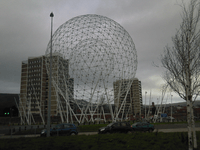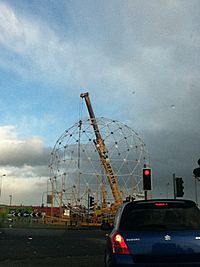RISE (sculpture) facts for kids
Quick facts for kids RISE |
|
|---|---|
 |
|
| Artist |
|
| Year | 2011 |
| Type | Steel |
| Dimensions | 37.5 m × 30 m (123 ft × 98 ft) |
| Location | Belfast, Northern Ireland |
RISE is the official name given to the public art sculpture located at Broadway Roundabout in Belfast, Northern Ireland. However, it has been given unofficial, colloquial titles such as the "Balls of the Falls", "the Testes on the Westes" and "the Westicles". These names have been derived by both the sculptures location on Broadway Junction (located above the A12 Westlink and in close proximity to the Falls Road) and in reference to its shape made from two, spherical, metal structures.
The RISE sculpture was designed by Wolfgang Buttress and consists of a geodesic sphere suspended inside a larger, 30 m (98 ft) diameter sphere and stands at an overall height of 37.5 m (123 ft). Geodesic refers to the shortest path between two points on a curve so that in the case of the RISE sculpture, adjacent connections on each of the spheres are connected using straight bars, thereby minimising the distance between two points. At 3om wide and 37.5m tall, RISE is the biggest public art sculpture in Belfast.
RISE was commissioned by Belfast City Council and built in 2011 as part of a multimillion-pound road improvement programme. It now sits atop of the A12 Westlink Underpass (a grade-separated junction) where, according to a 2009 NI assembly report, sees approximately 80,000 cars on average flow past it each day.
Concept and Construction
The globe-shaped, white and silver steel sculpture is a representation of a new sun rising to celebrate a new chapter in the history of Belfast. The inner sphere represents the sun rising over the bogs and the outer sphere represents the sun's halo, while the angled, steel supports are to represent the reeds of the bog meadows that extended more widely across the area before it was developed. Due to the Belfast's history of conflict and the location of the Westlink separating some of Belfast's unionist and nationalist communities, the sculpturer noted that it was important to design a sculpture that could be viewed in its 'roundness' from any angle and therefore any political or religious persuasion.
The sculptor encouraged input from local people living near the landmark sculpture, including the holding of creative workshops with groups from the Donegall Road and St James' areas of Belfast. This sculpture was favoured above others because of how it represents Belfast's positive outlook for a peaceful future. It was also favoured for its shape, which has neither a front or back but can be viewed equally from all angles.
Belfast City Council coordinated the plans for the new sculpture with strong support and funding from the Department for Social Development (Regeneration Directorate) and the National Lottery, through the Big Lottery Fund, through the Arts Council of Northern Ireland as well as advice and assistance from Department for Regional Development Roads Service.
Construction of the piece was challenging. The steel was fabricated by M Hasson and Sons Ltd in Rasharkin. GRAHAM Construction were appointed Principal Contractor and supervised the on site erection.
Work on RISE was due to begin in August 2009 and end in October 2009. However, due to delays the completion date was changed to March 2011. It was finally completed in September 2011, nearly two years behind the original schedule.
Structure
The artwork is made of two geodesic spheres supported on slender stanchions. The engineers, Price & Myers, made extensive use of the work done by Buckminster Fuller in the 1950s. The outer sphere has a geodesic frequency of 8. It required 1920 tubes to be bolted together. Tensigrity – another concept developed by Buckminster Fuller – is used to hold the inner sphere in position.
Competition
Buttress was selected after intense competition from more than 40 artists from the United Kingdom, the Republic of Ireland and internationally.
There had been a previous competition and previous winner: Trillian by Ed Carpenter. However, plans were scrapped amid escalating steel costs, which threatened to raise the price of the sculpture, originally agreed at £400,000, to £600,000.
Cost and Funding
Originally, the sculpture concept was estimated at a cost of £400,000. This final cost was reported in the region of £486,000, with £330,000 coming from the Department for Social Development, £100,000 coming from the Arts Council of Northern Ireland and £56,000 being supplied by Belfast City Council itself.
Workshop
In October 2009 school children and senior citizens from across Belfast worked with New Belfast Community Arts Initiative, local writers and the artist, Buttress, to look at plans for RISE, and to learn more about creative expression through workshops. The workshops were designed to give people an insight into the process involved in creating the sculpture, to give an opportunity to reflect on what it symbolises for Belfast, and to offer their own creative insights in response.


